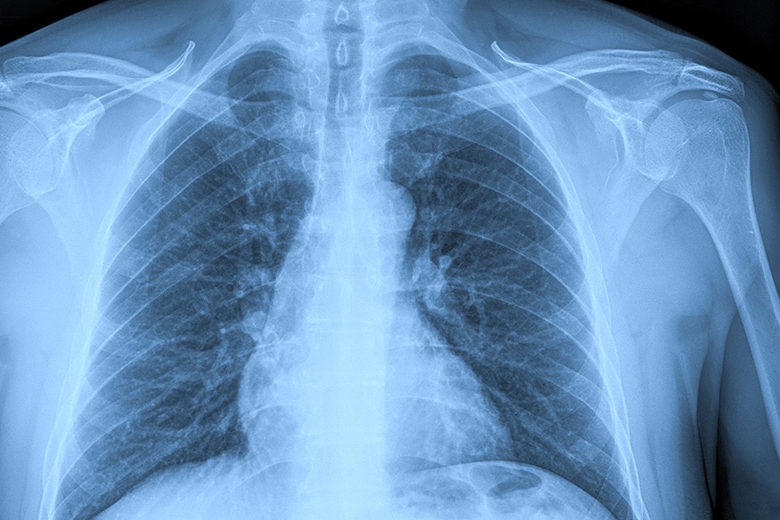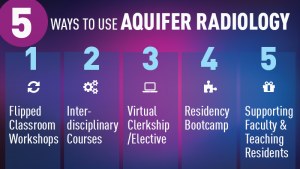

In collaboration with:
Association of Academic Radiology & Alliance of Medical Student Educators in Radiology
The 21 interactive virtual patient cases in Aquifer Radiology deliver on the learning objectives of the Association of Academic Radiology (AAR) and the Alliance of Medical Student Educators in Radiology (AMSER) medical student curriculum.
Overview
Aquifer Radiology’s virtual patient cases are realistic case scenarios that demonstrate best practices—helping students develop clinical reasoning skills that bridge the gap from classroom to practice. In an era of the increasing importance of evidence-based decision-making and reliance on imaging, an understanding of the principles and applications of radiology is vital for today’s healthcare professionals. The National Board of Medical Examiners has recognized this by increasing the imaging component of all United States Medical Licensing Examination exams.
Course Details
- Created for educators, by educators, utilizing the American College of Radiology (ACR) Appropriateness criteria
- Available for institutional subscription or for direct purchase by individual subscribers
- Access to Aquifer Calibrate: Transformative Assessments for Clinical Learning Mastery, our innovative system for formative assessment, available with your 2024-25 subscription
- Proven pedagogy that standardizes experiences—overcoming geography, seasonality, and accessibility
- Evidence-based, peer-reviewed, and continuously updated content
- Self-assessment questions emphasize key content and enable students to test their knowledge and skills
- A wealth of source material, tools, and full references in each case
- Educator resources, including complete flipped classroom PowerPoint workshops for each case—with speaker notes
- Delivered via the Aqueduct teaching and learning platform, which includes user management options, easy reporting on student progress and course usage, plus tools for creating custom courses to match a specific curriculum
Aquifer Radiology cases teach a patient-centered approach to imaging, foster self-directed and independent study, and build clinical problem-solving skills. The realistic case scenarios teach evidence-based decision making and include excellent interactive radiology resources.
These cases can be used as a stand-alone radiology course during a radiology clerkship or elective or incorporated into the appropriate clinical clerkships as part of a custom course created in Aqueduct. For example, the women’s imaging cases can be incorporated into an Ob-Gyn clerkship, thus teaching imaging at an applicable time.
Aquifer Calibrate, an innovative system for formative assessments, is available with your 2024-25 Aquifer Radiology institutional subscription. Calibrate combines the concepts of test-enhanced learning and distributed practice to facilitate efficient study planning and self-directed learning for students, and identify at-risk students and curricular gaps for faculty.
Radiology 01: 23-year-old male: Chest – Infection
Radiology 02: 51-year-old male: Chest – Masses
Radiology 03: 65-year-old male: Chest – Trauma
Radiology 04: 65-year-old female: Chest – Vascular and COPD
Radiology 05: 25-year-old male: GI – Colon and small bowel
Radiology 06: 42-year-old female: GI – Hepatobiliary and pancreas
Radiology 07: 40-year-old female: Renal/GU
Radiology 08: 18-year-old female & 19-year-old male: GI – Trauma
Radiology 09: 34-year-old male: Neuro – Trauma
Radiology 10: 40-year-old male: Neuro – Vascular and HIV
Radiology 11: 8-week old male – Pediatrics A
Radiology 12: 2-month old female – Pediatrics B
Radiology 13: 59-year-old female: MSK – Arthritis, osteomyelitis
Radiology 14: 28-year-old female—Pregnancy and infertility
Radiology 15: 43-year-old female – Malignancy and screening
Radiology 16: Musculoskeletal trauma
Radiology 17: 65-year-old male: Cardiac and Cardiovascular
Radiology 18: Professionalism in Radiology
Radiology 19: 53-year-old female: Oncology
Radiology 20: Interventional Radiology – Vascular
Radiology 21: Interventional Radiology – Nonvascular
From Our Cases
Flipped Classroom Workshops
Complete Aquifer Radiology Flipped Classroom Workshops are available for 18 cases—ready to use in your classroom. Each workshop, designed to be completed in a 60-90 minute session, includes a slide deck with images and annotations, speaker notes, and a facilitator guide.
User Stories
Learn how Aquifer Radiology can benefit medical students, residents, and faculty in your program:

On-Demand Webinar
Best Practices for Using Aquifer Radiology Across the Curriculum



